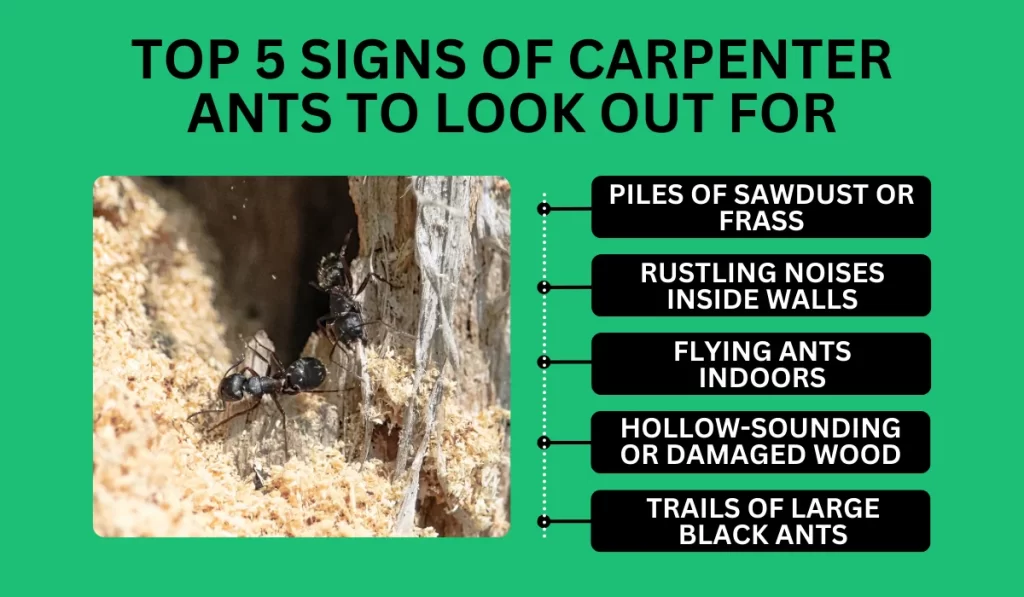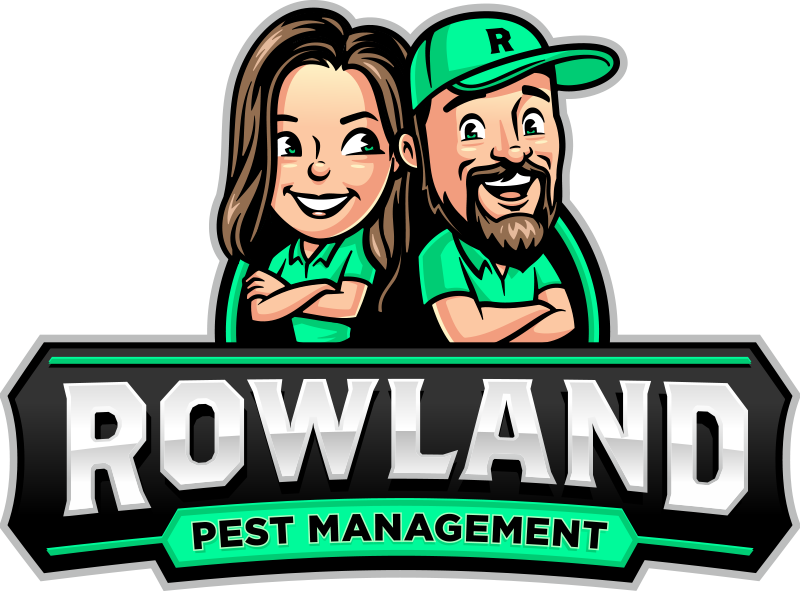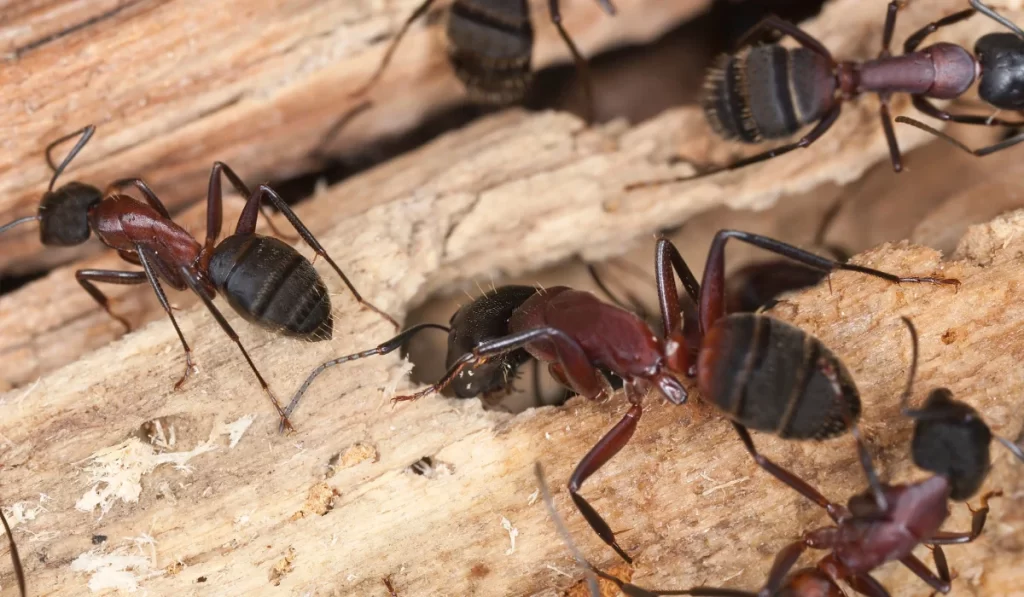In Central Florida, carpenter ants are a common pest that can cause significant damage to your property if left untreated. Carpenter ants cause millions of dollars in structural damage every year across the U.S. Unlike termites, they don’t eat wood—they tunnel through it to build nests.
But the result? Damaged wood, hollow beams, and costly repairs.
Knowing the early signs of a carpenter ant infestation can help you act fast and protect your home. Let’s break down the top warning signs to watch out for and what to do if you find them.
Key Takeaways
- Piles of sawdust, rustling noises, and flying ants indoors are strong signs of a carpenter ant infestation.
- Trails of large black ants and hollow-sounding wood often mean ants are nesting inside hidden wooden structures.
- Simple steps like sealing cracks, removing wood piles, and fixing leaks help stop ants from spreading further.
- Calling a pest control pro is the safest way to fully get rid of carpenter ants and prevent damage.

1. Piles of Sawdust or Frass
If you notice small piles of sawdust around your home, particularly beneath baseboards, window sills, or along wooden trims, you might be looking at frass, a telltale sign of carpenter ant activity.
Carpenter ants don’t consume wood. Instead, they excavate it to make room for their nests, kicking out the waste through small kick-out holes. These piles may also contain pieces of insulation, wood shavings, and even ant body parts.
Keep an eye out for wall voids, crevices, and crawl spaces, especially if the wood looks decayed or moist.
2. Rustling Noises Inside Walls
That soft rustling sound coming from your walls isn’t your imagination—it could be worker ants at work inside your walls. Rustling noises are most often heard at night when the house is quiet, and these ant species are most active.
If you tap on your walls and hear hollow spots, it could be due to tunneling through the woodwork.
A carpenter ant colony inside your walls can go undetected for a long time, especially if it’s a satellite nest branching off from a larger network.
3. Flying Ants Indoors
Seeing flying ants or swarmers inside your home, especially in the spring, usually signals that a carpenter ant nest is already inside. These winged ants leave the nest to start new colonies, and indoor sightings are a big red flag.
Swarmers are often confused with termites, but look closely, carpenter ants have a pinched waist and bent antennae.
You might also notice discarded wings near windows or vents, another clue that black carpenter ants have made themselves at home.
4. Hollow-Sounding or Damaged Wood
When a carpenter ant infestation has been going on for a while, the damage becomes visible. Tap along wooden structures like wood piles, trim, or floorboards. If it sounds hollow or splinters easily, that’s likely carpenter ant damage.
They especially like soft or decayed wood, making areas near plumbing, leaks, or under sinks prime real estate. Look for kickout holes, or small round openings, where ants toss out frass.
5. Trails of Large Black Ants
If you’re seeing trails of large ants, particularly ones with a heart-shaped thorax and dark color, those are likely worker ants from a carpenter ant colony.
These ants follow scent trails to food sources, often traveling from stumps or trees outdoors into your home. Indoors, they tend to stick close to kitchens and bathrooms where moisture gives them easy accessibility.
Regular sightings along ant trails near baseboards or under sinks are a classic sign of an infestation.
What to Do If You See the Signs of Carpenter Ants
Now that you know what to look for, here’s how to take action when you spot the signs of carpenter ants:
- Use caulk to close entry points such as cracks, holes, and gaps.
- Wipe up spills, store food in sealed containers, and fix any leaky plumbing.
- Remove nearby wood piles or tree limbs that provide easy access to your home.
- Avoid ineffective DIY repellents, even if they might seem like a quick fix.
Get Rid of Carpenter Ants the Right Way with a Professional Pest Control Company
If you’re a homeowner in Central Florida dealing with a carpenter ant infestation, Rowland Pest Management is here to help. Our trained technicians understand the local environment and know exactly where these pests like to hide.
Whether it’s a carpenter ant nest in the attic or trails near the garage, we’ll find it, treat it, and make sure it doesn’t come back.
We use smart ant control strategies that minimize disruption and maximize results, with no unnecessary spraying, and we always prioritize your family’s safety. Our approach to pest management focuses on long-term prevention, not just quick fixes.
Contact us now for your free inspection.
Frequently Asked Questions
If you’re still wondering about carpenter ants after spotting the warning signs, you’re not alone. Here are some common questions we hear from homeowners that can help you understand the problem a little better:
Can carpenter ants damage outdoor areas like decks or fences?
Yes, carpenter ants often start nesting in decayed wood outside, like in decks, fences, or tree stumps, before moving indoors. Catching them early outdoors can help prevent bigger problems later.
Do carpenter ants only infest old or damaged homes?
No, carpenter ants can infest any home, old or new, especially if there’s moisture. Even well-built houses with minor leaks or soft wood can attract them and give them a place to nest.
Will carpenter ants go away on their own without treatment?
No, they won’t leave on their own. Once they’ve built a nest, they’ll continue expanding and causing damage unless they’re properly removed by a professional pest control team.


